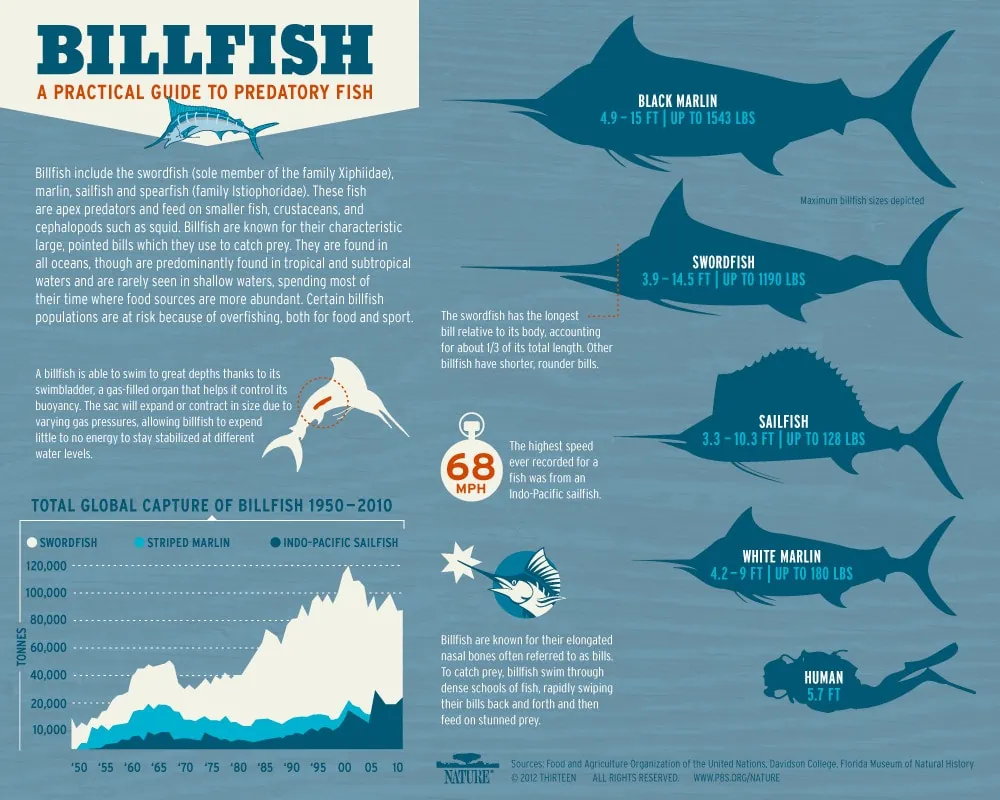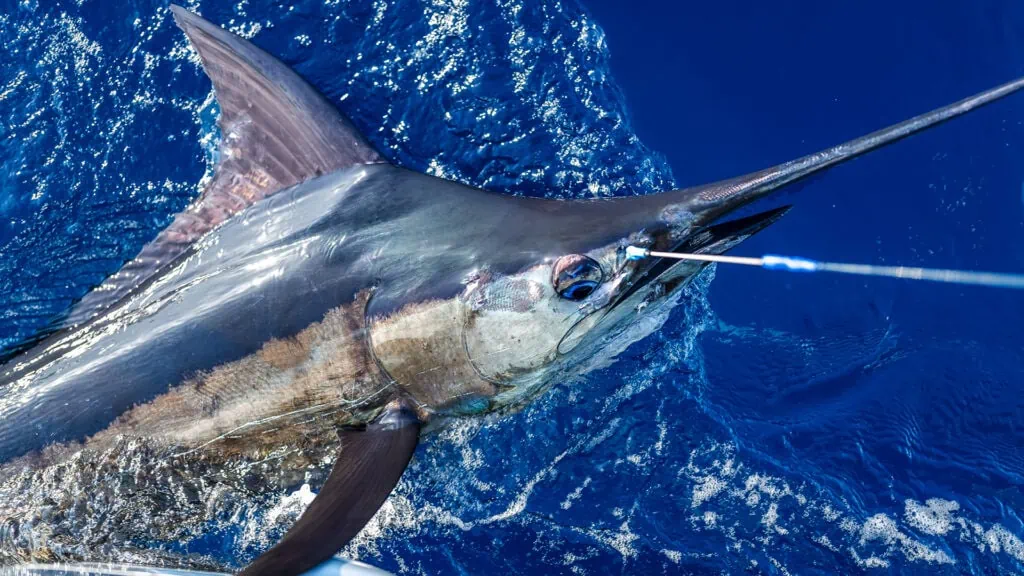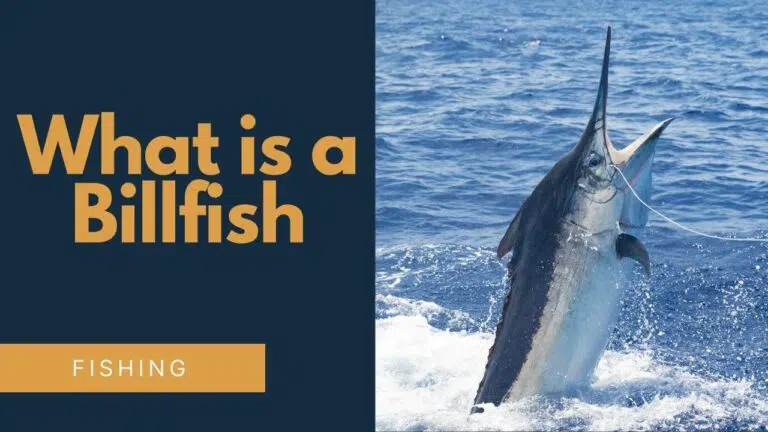Have you ever heard of billfish and wondered what makes them so unique from other fish?
In this article, we’ll explore the fascinating world of billfish and answer some of the most common questions about these majestic creatures.
What is a Billfish?
Billfish (or Bill Fish) is a collective term used to describe a group of large predatory fish characterized by their elongated bills or rostrums. These fish belong to the family Istiophoridae and include species like marlins, sailfish, and swordfish.
Table of Contents
- What is a Billfish?
- How Many Species Of Billfish Are There?
- Billfish Infographic:
- The Purpose of the Bill on Billfish
- Billfish Predators and Prey: What Do Billfish Eat?
- The Biggest Billfish
- Small but Mighty: The Smallest Billfish Species
- Where to Catch Billfish
- A Billfish “Grand Slam”
- The Fastest Billfish
- A Culinary Delight: Can You Eat Billfish?
- Protecting Billfish: Conservation Challenges and Efforts
- FAQ
How Many Species Of Billfish Are There?
| Billfish Type | Description |
|---|---|
| Blue marlin (Makaira nigricans) | One of the largest billfish species with a long, pointed bill and sail-like dorsal fin. Blue-black on top and silver-white on the bottom. Known for speed, strength, and leaping ability. |
| Black marlin (Istiompax indica) | Similar appearance to the blue marlin but generally darker in color. Has a long, slender bill and a sail-like dorsal fin. Known for incredible speed and powerful swimming. |
| White marlin (Kajikia albida) | A smaller species of marlin with a slender body and a shorter bill. Bluish-grey on top and silvery-white underside. Agile and fast swimmer. |
| Striped marlin (Kajikia audax) | Characterized by vertical blue stripes on the body, a slender body, a long bill, and a high dorsal fin. Known for speed and acrobatic displays when hooked. |
| Sailfish (Istiophorus platypterus) | Known for the large sail-like dorsal fin, long slender body, and a distinctive bill. Dark blue on top with a silver-white underside. Considered the fastest fish in the ocean. |
| Swordfish (Xiphias gladius) | Characterized by a long, flat, sword-like bill and a large, streamlined body. Dark bluish-grey on top and lighter on the bottom. Strong, fast swimmer with the ability to dive to great depths. |
| Longbill spearfish (Tetrapturus pfluegeri) | Features a long, slender body, a pointed bill, and a sail-like dorsal fin. Dark blue on top and silvery-white underside. Fast swimmer found in warm, open ocean waters. |
| Shortbill spearfish (Tetrapturus angustirostris) | Similar to the longbill spearfish but with a shorter bill. Sail-like dorsal fin, slender and streamlined body. Dark blue on top and silver-white on the bottom. Found in tropical and subtropical oceanic waters. |
Billfish Infographic:

The Purpose of the Bill on Billfish
You might be wondering why billfish have such distinctive, elongated bills.
The bill of a billfish has evolved as a useful adaptation for hunting that billfish use to slash at schools of small fish, stunning or injuring them, which makes it easier for them to scoop up their prey.
Billfish have also been known to thrust directly into prey in more of a stabbing motion, but this is less common.
Fun Fact: Fishermen have frequently found the bills of billfish in the hulls of their boats, sometimes penetrating into the interior where it can be seen from the cabin. It is believed, however, that this wasn’t an intentional attack by the fish but rather an accident.
Billfish Predators and Prey: What Do Billfish Eat?
Billfish primarily eat a diet of smaller fish and cephalopods. Some of their preferred prey include tuna, mackerel, flying fish, squid, and octopus.
Billfish are also known for their speed and agility in the water, which enables them to effectively hunt and capture these smaller prey.
What Eats Billfish?
Billfish aren’t always the hunters. They have their own predators, too!
Large sharks, such as the great white, tiger shark, and mako shark, are known to prey on billfish. Occasionally, marine mammals like killer whales have also been observed hunting these swift swimmers.
The Biggest Billfish

The blue marlin is the biggest of the billfish species, with females capable of growing up to 15 feet long and weighing more than 1,800 pounds! Males are usually smaller, reaching a maximum length of about 10 feet.
The Biggest Marlin Caught:
Although Blue Marlin are considered the largest fish in the ocean, the biggest Marlin ever caught was a Black Marlin that weighed in at over 1500lbs.
Small but Mighty: The Smallest Billfish Species
The smallest billfish species is the shortbill spearfish, which typically grows up to 7 feet in length and can weigh up to 90 pounds. Despite their smaller size, they’re still formidable predators.
Fun Fact: The Shortbill Spearfish is also the rarest of all Billfish and highly coveted by anglers that are trying to catch every species of billfish in a lifetime.
Where to Catch Billfish
Billfish inhabit tropical and subtropical waters around the world, making them a sought-after target for sportfishing enthusiasts. Some of the most popular locations to catch billfish include the waters off:
- Costa Rica
- Mexico
- Florida
- Caribbean
The best time to fish for billfish varies depending on the location and species.
A Billfish “Grand Slam”
In the world of billfish fishing, the “Grand Slam” refers to catching three different billfish species in a single day.
This is a rare and highly coveted achievement, as it requires skill, luck, and perfect timing. Some variations of the Grand Slam include the Royal Slam (catching all the species of billfish in a lifetime) and the Fantasy Slam (catching five different billfish species in one day).
The Fastest Billfish
Among the species, the sailfish is known to be the fastest billfish. They can reach speeds of up to 68 miles per hour, making them one of the fastest fish in the ocean.
Their speed, combined with their agility, makes them formidable predators and a challenge for anglers to catch.
A Culinary Delight: Can You Eat Billfish?
Yes, you can eat billfish! Swordfish is the most commonly consumed species, known for its firm, meaty texture and mild flavor. However, other species, like marlin, can also be enjoyed as a culinary delight.
Billfish are often grilled or seared, and their dense flesh holds up well to various cooking methods. However, it’s essential to source billfish responsibly, as some populations face overfishing and declining numbers.
Make sure to purchase from a sustainable source and follow local regulations if you’re catching billfish yourself.
Protecting Billfish: Conservation Challenges and Efforts
Billfish populations face various threats, including overfishing, bycatch, and habitat loss. While not all species are classified as endangered, some, like the Atlantic blue marlin and white marlin, are listed as “Vulnerable” by the IUCN.
Billfish are protected through national and international regulations, such as catch limits, size restrictions, and marine protected areas. Organizations like ICCAT and IATTC also work to manage and conserve billfish populations in their respective regions.
By understanding these challenges and supporting conservation efforts, we can help protect these incredible creatures and their habitats for future generations.
FAQ
-
Are Billfish and Swordfish the same?
A Swordfish is a member of the Billfish Species but is different from the other species of Billfish, such as Marlin and Sailfish.
-
Can you take a billfish out of the water?
Yes, you can take a billfish out of the water for a very short period of time; however, you should not do this very often because billfish are very stressed during a fight, and removing them from the water after fighting them dramatically increases the risk that the fish will not survive.
-
What is the most prized Billfish?
The Blue Marlin is the most sought-after of all the Billfish, with the Black Marlin coming in at a close second. Sailfish are definitely the most common billfish targeted around the world.











